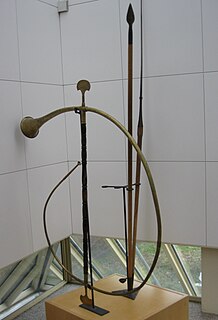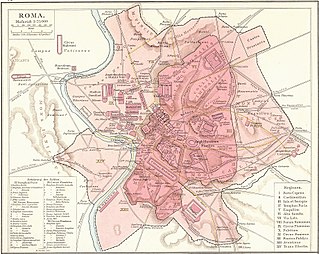Related Research Articles

Caracalla, formally known as Antoninus, ruled as Roman emperor from 198 to 217 AD. He was a member of the Severan dynasty, the elder son of Septimius Severus and Julia Domna. Co-ruler with his father from 198, he continued to rule with his brother Geta, emperor from 209, after their father's death in 211. He had his brother killed later that year, and reigned afterwards as sole ruler of the Roman Empire. Caracalla's reign featured domestic instability and external invasions by the Germanic peoples.

The Rostra was a large platform built in the city of Rome that stood during the republican and imperial periods. Speakers would stand on the rostra and face the north side of the comitium towards the senate house and deliver orations to those assembled in between. It is often referred to as a suggestus or tribunal, the first form of which dates back to the Roman Kingdom, the Vulcanal.

The Temple of Portunus or Temple of Fortuna Virilis is a Roman temple in Rome, Italy, one of the best preserved of all Roman temples. Its dedication remains unclear, as ancient sources mention several temples in this area of Rome, without saying enough to make it clear which this is. It was called the Temple of Fortuna Virilis from the Renaissance, and remains better known by this name. If dedicated to Portunus, the god of keys, doors and livestock, and so granaries, it is the main temple dedicated to the god in the city.

The Baths of Diocletian were public baths in ancient Rome, in what is now Italy. Named after emperor Diocletian and built from 298 AD to 306 AD, they were the largest of the imperial baths. The project was originally commissioned by Maximian upon his return to Rome in the autumn of 298 and was continued after his and Diocletian's abdication under Constantius, father of Constantine.

Maya codices are folding books written by the pre-Columbian Maya civilization in Maya hieroglyphic script on Mesoamerican bark paper. The folding books are the products of professional scribes working under the patronage of deities such as the Tonsured Maize God and the Howler Monkey Gods. Most of the codices were destroyed by conquistadors and Catholic priests in the 16th century. The codices have been named for the cities where they eventually settled. The Dresden codex is generally considered the most important of the few that survive.

The Dresden Codex is a Mayan book, the oldest surviving from the Americas, dating to the 13th or 14th century. The codex was rediscovered in the city of Dresden, Germany, hence the book's present name. It is located in the museum of the Saxon State Library.

In Roman architecture, an insula was one of two things: either a kind of apartment building, or a city block. This article deals with the former definition, that of a type of building.
A Topographical Dictionary of Ancient Rome is a reference work written by Samuel Ball Platner and completed by Thomas Ashby after Platner's death that was published in 1929 by Oxford University Press. Referred to as 'Platner and Ashby', the volume describes the ancient monuments and buildings in the city of Rome, although by and large only if they belong to the classical period. It covers both remains that are still extant and buildings of which not a trace remains, and collates source documents for each. This volume was, for fifty or sixty years, the standard reference in the field of Roman topography, having superseded Rodolfo Lanciani's Forma Urbis. Platner and Ashby has since itself been superseded by a reworking, L. Richardson, Jr.'s A New Topographical Dictionary of Ancient Rome, but mostly by the new standard, a completely new work, Eva Margareta Steinby's Lexicon Topographicum Urbis Romae.
The Itinerarium Burdigalense — also known as the Itinerarium Hierosolymitanum — is the oldest known Christian itinerarium. It was written by the "Pilgrim of Bordeaux", an anonymous pilgrim from Burdigala. It recounts the writer's journey to the Holy Land in the years 333 and 334 as he traveled by land through northern Italy and the Danube valley to Constantinople, then through Asia Minor and Syria to Jerusalem, and then back by way of Macedonia, Otranto, Rome, and Milan.

In Ancient Rome the month of March was the traditional start of the campaign season, and the Tubilustrium was a ceremony to make the army fit for war. The ceremony involved sacred trumpets called tubae.

The Comitium was the original open-air public meeting space of Ancient Rome, and had major religious and prophetic significance. The name comes from the Latin word for "assembly". The Comitium location at the northwest corner of the Roman Forum was later lost in the city's growth and development, but was rediscovered and excavated by archeologists at the turn of the twentieth century. Some of Rome's earliest monuments; including the speaking platform known as the Rostra, the Column Maenia, the Graecostasis and the Tabula valeria were part of or associated with the Comitium.

The traditions of indigenous Mesoamerican literature extend back to the oldest-attested forms of early writing in the Mesoamerican region, which date from around the mid-1st millennium BCE. Many of the pre-Columbian cultures of Mesoamerica are known to have been literate societies, who produced a number of Mesoamerican writing systems of varying degrees of complexity and completeness. Mesoamerican writing systems arose independently from other writing systems in the world, and their development represents one of the very few such origins in the history of writing. The conquistadors brought their distinctive cultural creations, in the form of books, from Europe to the New World which further influenced native literature.

The Arch of Gallienus is a name given to the Porta Esquilina, an ancient Roman arch in the Servian Wall of Rome. It was here that the ancient Roman roads via Labicana and via Tiburtina started.

The topography of ancient Rome is a multidisciplinary field of study that draws on archaeology, epigraphy, cartography and philology.

The Church of San Pellegrino in Vaticano is an ancient Roman Catholic oratory in the Vatican City, located on the Via dei Pellegrini. The church is dedicated to Saint Peregrine of Auxerre, a Roman priest appointed by Pope Sixtus II who had suffered martyrdom in Gaul in the third century. It is one of the oldest churches in the Vatican City.
Many travellers in Lombard Italy during the sixth through eighth centuries wrote down inscriptions in syllogae, providing an important record of what was left of ancient Rome during the Lombard period. Generally written by Anglo-Saxons, the syllogae demonstrate that inscriptions were plentiful along the via Flaminia and in the city of Rome.
Lawrence Richardson Jr. was an American Classicist and ancient historian educated at Yale University who was a member of the faculty of classics at Duke University from 1966 to 1991. He was married to the Classical archaeologist Emeline Hill Richardson. Richardson received numerous fellowships, including a Fulbright, a Guggenheim, and support from the American Council of Learned Societies. He was a Fellow of the American Academy in Rome (1950) and field director of the AAR's Cosa excavations (1952–1955). He was a Resident of the American Academy in Rome (1979), and served as the American Academy in Rome’s Mellon Professor-in-Charge of the School of Classical Studies (1981). In 2012 he was awarded the Gold Medal of the Archaeological Institute of America.
The Murus Terreus Carinarum is an obscure earthwork fortification of the ancient city of Rome known from a passage in the works of Varro. The Murus Terreus may have been a part of Rome's earliest fortifications, often referred to as the Servian Wall. While the location of the Murus Terreus remains unknown and debated, it is thought likely that it belonged to the fortifications of the Oppian Hill, thus placing it between the Carinae and the Subura. Pinza suggested that the works were located on the summit of the Oppian.
The Arch of Gratian, Valentinian and Theodosius was a triumphal arch built between 379 and 383 AD in Rome. It was situated at the south end of the Pons Aelius, near to the site later occupied by the church of San Celso. It formed as a monumental entrance arch to the bridge.

The Lumbini pillar inscription, all called the Paderia inscription, is an inscription in the ancient Brahmi script, discovered in December 1896 on a pillar of Ashoka in Lumbini, modern Nepal by Alois Anton Führer. Another famous inscription discovered nearby in a similar context is the Nigali-Sagar inscription. The Lumbini inscription is generally categorized among the Minor Pillar Edicts of Ashoka, although it is in the past tense and in the ordinary third person, suggesting that it is not a pronouncement of Ashoka himself, but a rather later commemoration of his visit in the area.
References
- ↑ James William Ermatinger (2007). Daily Life of Christians in Ancient Rome. Greenwood Publishing Group. pp. 186–. ISBN 978-0-313-33564-8.
- ↑ Richard Jenkyns (1992). The Legacy of Rome: A New Appraisal. Oxford University Press. pp. 298–. ISBN 978-0-19-821917-0.
- 1 2 L. Richardson, jr (1 October 1992). A New Topographical Dictionary of Ancient Rome . JHU Press. pp. 21–. ISBN 978-0-8018-4300-6.
- ↑ Samuel Ball Platner (21 May 2015). A Topographical Dictionary of Ancient Rome. Cambridge University Press. pp. 20–. ISBN 978-1-108-08324-9.
- ↑ Thomas F. X. Noble (25 February 2012). Images, Iconoclasm, and the Carolingians. University of Pennsylvania Press. pp. 138–. ISBN 0-8122-0296-1.
- ↑ Tyler Lansford (14 January 2011). The Latin Inscriptions of Rome: A Walking Guide. JHU Press. pp. 505–. ISBN 978-1-4214-0325-0.